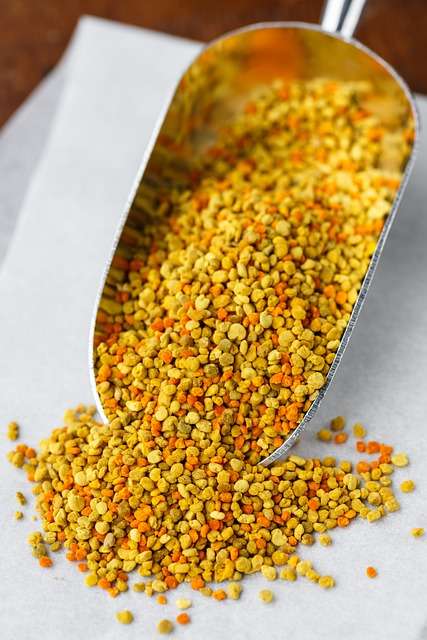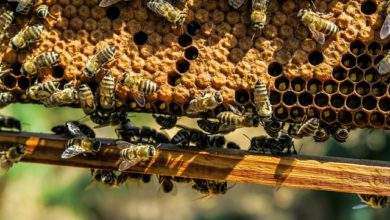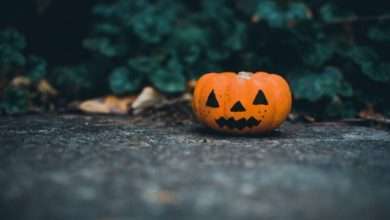How to Collect Pollen from Bees

Are you interested in beekeeping or looking to harvest pollen from bees for its rich nutrients?
If so, then you’ve come to the right place. Pollen is a valuable resource and can be collected and used in a variety of ways like for creating delicious cookies or enjoyed as a health supplement. Here, you will learn an easy, three-step method to collecting pollen from bees.
How to Collect Pollen from Bees
As a beekeeper or gardener, it is important to collect pollen from bees to ensure healthy plants and bees. Pollination is essential for a successful harvest, and collecting pollen from bees is a great way to strengthen our agricultural ecosystem. In this chapter, we will go through the steps of collecting pollen from bees and discuss why it is important for beekeepers and gardeners alike.
The process of collecting pollen from bees is relatively simple. Bees collect pollen as a source of protein to feed their young. As they move from flower to flower, they brush up against the anthers, and pollen gets stuck to their furry bodies.
To collect this pollen, beekeepers use a device called a pollen trap, which is placed at the entrance of the beehive. As the bees enter or leave the hive, the trap brushes the pollen from their bodies, collecting it in a tray. This tray can be removed and emptied into a container for later use.
Benefits for Beekeepers
Collecting pollen from bees has several benefits for beekeepers. Firstly, it can be used as a supplement for the bees’ usual diet of honey, providing them with additional nutrition. This can help to strengthen the bees’ immune systems, making them less susceptible to disease and pests.
Secondly, pollen collection can be a source of income for beekeepers. High-quality pollen can be sold to other beekeepers or used in the production of nutritional supplements for humans.
Collecting pollen from bees can be a delicate process that requires a deep understanding of bee behavior. It is essential to approach bees with caution and respect to avoid disturbing their routine and agitating them.
Understanding Bee Behavior
The behavior of bees plays a critical role in the collection of pollen. Bees can collect pollen from a wide range of sources, including flowers, trees, and grasses. They are attracted to pollen due to its high nutritional value, and they use it to feed their larvae and themselves. When bees collect pollen, they carry it on their bodies, where it mixes with nectar to create bee bread.
To collect pollen from bees, it is essential to understand their behavior during this process. Bees typically collect pollen in the morning when the flowers they are visiting have freshly opened.
They focus on collecting pollen from a single type of flower during a collection trip, making it easier to identify the source of the pollen. Bees also have a unique way of collecting pollen, using their front legs to brush the pollen off the flower and onto their bodies.
Observing Bees
Observing bees is a crucial aspect of collecting pollen. It helps you understand their behavior and identify the right time for collection. It is essential to approach bee colonies with caution and respect, as disturbing them can lead to aggression and stinging. Observing bees from a safe distance is the best way to gain an understanding of their behavior.
When observing bees, it is essential to pay attention to their flight patterns and the direction of their arrival and departure. Bees tend to follow a set flight path when visiting flowers, allowing you to identify the source of the pollen they are collecting.
You can also observe the color of the pollen on the bee’s bodies, which can help you identify the type of flower they are visiting.
Identifying the Right Time for Collection
Identifying the right time for pollen collection is crucial to ensure that you collect a sufficient amount of pollen. Bees tend to collect the most pollen during the early morning hours when the flowers they are visiting have freshly opened. They also tend to collect less pollen during hot and dry weather.

To ensure a successful pollen collection, it is best to wait until later in the morning before collecting pollen from bees. It is also essential to choose a site that has a high concentration of flowers that are actively being visited by bees. When collecting pollen, it is crucial to avoid disturbing the bees and to collect pollen from a variety of bees to ensure a diverse collection.
Preparing for Pollen Collection
Before you start collecting pollen, it is important to prepare the necessary equipment and tools.
You will need:
- Pollen traps
- Collection trays
- A scraper or brush
- Ziplock bags or containers for storing pollen
Setting Up the Collection Area
Once you have your equipment, you will need to set up a collection area near the entrance of your beehive. This area should consist of a trapping mechanism or trays that will collect the pollen as the bees fly in and out of the hive. It is important to place the collection area in a safe and secure location, away from potential predators or other hazards.
Safety Precautions to Take
Collecting pollen from bees can be a delicate and potentially dangerous process if not properly executed. Here are a few safety precautions to keep in mind:
- Always wear protective gear such as gloves, veils, and suits to avoid bee stings.
- Make sure to use non-toxic materials for your collection trays and pollen storage containers to avoid contamination.
- Avoid disturbing the bees too much during the collection process to prevent damage to the hive or harm to the bees.
As you can see, collecting pollen from bees is a specific process that requires the proper tools, equipment, and safety precautions. By following these steps, you can successfully collect high quality pollen that can be used for a variety of purposes.
Techniques for Collecting Pollen from Bees
- Using a Pollen Trap: This method involves the use of a specially designed box that is attached to the entrance of the beehive. The box is designed with a screen that catches the pollen from the bees as they enter the hive.
- Hand Collection: This technique involves using a gentle brush, such as a soft-bristled paintbrush, to brush the pollen off the bees’ bodies. It is important to be gentle when using this technique to avoid harming the bees.
Tips for Making the Process Easier
- Use the Right Tools: When collecting pollen from bees, make sure you have the right tools. Use a pollen trap designed for the job or a bee brush to avoid injuring the bees.
- Choose a Sunny Day: Bees are most active during sunny days. Choose a day when it’s sunny outside to increase your chances of capturing high-quality pollen.
- Avoid Disturbing the Hive: Bees are naturally defensive creatures. Avoid disturbing the hive when collecting pollen to reduce the risk of being stung.
Alternatives to Traditional Methods of Collecting Pollen
- Handheld Vacuum: A handheld vacuum designed for collecting pollen from bees is becoming increasingly popular. The vacuum sucks the pollen directly from the bees and stores it in a compartment for later use.
- Beehive Air Blower: Similar to the handheld vacuum, the beehive air blower uses an air compressor to blow the pollen off the bees without harming them.
Storing Collected Pollen
After successfully collecting pollen from the bees, it’s essential to store it properly to maintain its purity and nutritional value. Here are some tips for storing collected pollen:
Choosing the Right Storage Location
The storage location should be dry and cool with low humidity. It’s best to store pollen in a place where the temperature is between 10-15°C (50-59°F) and humidity levels are below 50%.
The storage location should also be protected from direct sunlight, as ultraviolet (UV) radiation can destroy the nutritional value of the pollen.
Storing Pollen in Containers
To store pollen, you can use plastic or glass containers with a tight-fitting lid. Make sure that the containers are clean and dry before storing the pollen. It’s important to keep the pollen away from moisture, so avoid using containers that are not airtight.
If you plan to sell the pollen, it’s best to label the containers with the date of collection, the origin of the pollen, and any other relevant information.
Understanding the Shelf Life of Collected Pollen
Collected pollen has a shelf life of up to two years when stored properly. However, as time goes by, the nutritional value of the pollen decreases. To ensure that the pollen is still effective, it’s best to use it within six months of collection.
Benefits of Using Collected Pollen
Collecting pollen from bees has numerous benefits, including:
Enhancing bee health
- Pollen is a vital source of nutrition for bees, and it plays a crucial role in their growth and development. Adding collected pollen to their diet helps to boost their immunity, increase their energy levels, and promote their overall health.
Enhancing human health
- Collected pollen contains numerous minerals, vitamins, and antioxidants that provide various health benefits to humans. Some of these benefits include improving heart health, boosting immunity, treating allergies, and improving digestive health.
Various Applications for Collected Pollen
Collected pollen has numerous applications, including:
- Nutritional supplements – Collected pollen can be consumed as a nutritional supplement by humans. It is available in various forms, including capsules, powders, and granules.
- Skin care – Collected pollen has numerous benefits for the skin. It contains antioxidants that help to prevent premature aging, reduce inflammation, and improve skin texture.
- Cooking – Collected pollen can be used in cooking as a natural sweetener. It has a unique taste and can be added to smoothies, baked goods, and other recipes.
Incorporating Collected Pollen in Gardening and Beekeeping
Here are some tips on how to incorporate collected pollen in gardening and beekeeping:
Feed it to bees
- Adding collected pollen to a bee’s diet helps to boost their immunity, promote their health, and increase their honey production.
Add it to compost
- Adding collected pollen to compost improves soil fertility and helps to promote the growth of healthy plants.
Use it for seed starting
- Collected pollen can be used to start seedlings. It contains the nutrients necessary for healthy plant growth, and it helps to promote root development.
Conclusion
Collecting pollen from bees is a fun and easy way to enjoy the honey bee process.

With the right preparation and tools, you can now feel confident in your ability to harvest this important resource.
Plus, you’ll have an endless supply of pollen to enjoy however you want. There are many ways to enjoy pollen and it can be used in cooking, medicinal purposes, or simply used as a therapeutic tool. Try out this three-step method for collecting pollen from bees and enjoy the benefits of this valuable resource.
FAQ
What is bee pollen and how is it collected by bees?
- Bee pollen is a mixture of flower pollen, nectar, enzymes, honey and wax used as a food source for young bees. Honey bees fly from one flower to another, mainly collecting pollen from the stamens of the flowers which is then stored in their pollen baskets as they return to the hive.
Can bee pollen help with allergies?
- Yes, bee pollen is known to help with allergies as it contains small amounts of allergens which can help build up your immune system and decrease your body’s sensitivity to the allergen.
Can bee pollen upset your stomach?
- While bee pollen is generally safe to consume, it may cause an upset stomach or other digestive issues in some individuals. Be sure to start with small amounts and monitor how your body reacts before consuming larger quantities.
What are the health benefits of consuming bee pollen?
- Bee pollen has a wide variety of potential health benefits, including improved energy levels, increased immunity, and decreased inflammation throughout your body. It is also a rich source of vitamins, minerals and antioxidants.
Is bee pollen safe for those with bee allergies?
- No, bee pollen is not recommended for those with bee allergies as it may trigger an allergic reaction. Always consult with your doctor before consuming bee pollen if you have a history of allergies.
What is the recommended daily dose of bee pollen?
- The recommended daily dose of bee pollen varies based on your age, health status and intended use. Consult with a healthcare provider to determine the appropriate dose for you.
Can bee pollen be used in cooking or baking?
- Yes, bee pollen can be incorporated into recipes as a natural sweetener or added to smoothies, yogurt or oatmeal for an added nutritional boost.
Is bee pollen safe for pregnant or breastfeeding women?
- It is recommended for pregnant or breastfeeding women to consult with their healthcare provider before consuming bee pollen as there is not enough research to determine its safety in these populations.
How long does bee pollen last?
- Bee pollen has a relatively long shelf life and can last up to 2 years if stored properly. As with any food product, be sure to check for any signs of spoilage or rancidity before consuming.




